
Orange County is a county located in the U.S. state of New York. As of the 2020 census, the population was 401,310. The county seat is Goshen. This county was first created in 1683 and reorganized with its present boundaries in 1798.
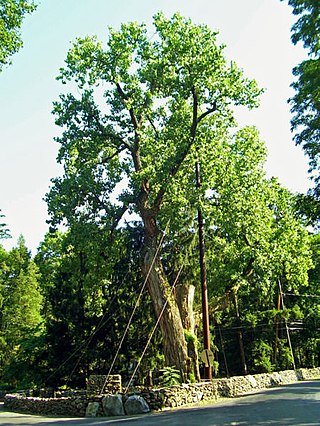
Balmville is a hamlet in Orange County, New York, United States. It is part of the Poughkeepsie–Newburgh–Middletown, NY Metropolitan Statistical Area as well as the larger New York–Newark–Bridgeport, NY-NJ-CT-PA Combined Statistical Area. It is located in the southeastern part of the Town of Newburgh. The population was 3,197 at the 2020 census. Many wealthy, influential, and upper income families live in Balmville on roads such as River Road, Sloane Road, Commonwealth Avenue, Susan Drive, and Grand Avenue. Susan Drive is accredited for housing the former Delano Family Estate (Algonac). The Delano family was the family of the mother of Franklin D. Roosevelt, and she in fact was born and raised at Algonac. Many homes in Balmville are incredibly expensive due to their pristine views of the Hudson River. Balmville is also the site of the Powelton Club Country Club. It currently ranks as the highest income hamlet in the greater Newburgh area.

Middletown is the largest city in Orange County, New York, United States. It lies in New York's Hudson Valley region, near the Wallkill River and the foothills of the Shawangunk Mountains. Middletown is situated between Port Jervis and Newburgh, New York. At the 2020 United States census, the city's population was 30,345, reflecting an increase of 2,259 from the 28,086 counted in the 2010 census. The zip code is 10940. Middletown falls within the Poughkeepsie–Newburgh–Middletown Metropolitan Statistical Area, which belongs to the larger New York–Newark–Bridgeport, NY–NJ–CT–PA Combined Statistical Area.

Stewart International Airport, officially New York Stewart International Airport, is a public/military airport in Orange County, New York, United States. It is in the southern Hudson Valley, west of Newburgh, south of Kingston, and southwest of Poughkeepsie, approximately 60 miles (97 km) north of Manhattan, New York City. The airport is located within the towns of Newburgh and New Windsor. It is included in the Federal Aviation Administration (FAA) National Plan of Integrated Airport Systems for 2017–2021, in which it is categorized as a non-hub primary commercial service facility.

Newburgh is a town in Orange County, New York, United States. It forms part of the Poughkeepsie—Newburgh—Middletown metropolitan area, which is a part of the New York megacity, and is a suburban satellite of the urbanized city of Newburgh. The city of Newburgh was a part of the town prior to 1865. New York Stewart International Airport is partially located within the township, and much of the land into which it could have been expanded has been turned into Stewart State Forest.
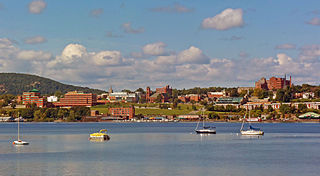
Newburgh is a city in Orange County, New York, United States. With a population of 28,856 as of the 2020 census, it is a principal city of the Poughkeepsie–Newburgh–Middletown metropolitan area. Located 60 miles (97 km) north of New York City, and 90 miles (140 km) south of Albany on the Hudson River within the Hudson Valley Area, the city of Newburgh is located near Stewart International Airport, one of the primary airports for Downstate New York.

The Hudson Valley comprises the valley of the Hudson River and its adjacent communities in the U.S. state of New York. The region stretches from the Capital District including Albany and Troy south to Yonkers in Westchester County, bordering New York City.

New York State Route 17K (NY 17K) is an east–west state highway located within Orange County, New York, in the United States. It extends for 22.01 miles (35.42 km) from an intersection with NY 17 east of Bloomingburg to a junction with U.S. Route 9W (US 9W) midway across the city of Newburgh. The western terminus was where NY 17K originally connected to its parent route, NY 17; it now meets NY 17 a short distance to the east at an interchange with the Quickway. In Newburgh, NY 17K becomes Broadway and serves as the city's primary east–west street. The road can be divided into a half west of Montgomery, where it runs through relatively undeveloped land, and an eastern half where it closely parallels Interstate 84 (I-84) and serves much more populated areas.

List of the National Register of Historic Places listings in Orange County, New York

The Newburgh–Beacon Ferry is a ferry service crossing the Hudson River that connects Newburgh with Beacon, New York.

The Dutch Reformed Church is one of the most prominent architectural landmarks in Newburgh, New York. It was designed by Alexander Jackson Davis in 1835 in the Greek Revival style just after the dissolution of his partnership with Ithiel Town. It is his only surviving church in that style and is considered to be his latest building still standing that largely reflects his original vision. The church stands at 132 Grand Street, just north of the Newburgh Free Library.
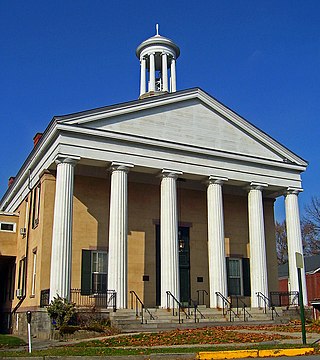
The 1841 Goshen Courthouse is located along Main Street in the center of Goshen, New York, the seat of Orange County, New York, United States. It was designed by popular local architect Thornton M. Niven in a Greek Revival style, meant to be a twin of the one he had already built in Newburgh, which at that time shared seat duties with the larger city. Construction of the building was approved by the county legislature in April 1841 and began shortly thereafter.

Moodna Creek is a small tributary of the Hudson River that drains eastern Orange County, New York. At 15.5 miles (25 km) in length from its source at the confluence of Cromline Creek and Otter Kill west of Washingtonville, it is the longest stream located entirely within the county.
The Newburgh Enlarged City School District is a public school district located in Newburgh, New York. It encompassed all of the City of Newburgh, and most of the Towns of Newburgh and New Windsor. The enrollment is 12,791 students in 13 schools in grades K-12.

Powelton Club is located between US 9W, Interstate 84, Balmville Road and Chestnut Lane in the hamlet of Balmville, New York, United States, just north of the city of Newburgh, in the Town of Newburgh. Originally established as an archery club, it is one of the five oldest golf courses in the state, and the ten oldest in the U.S. It has been listed on the National Register of Historic Places since 1999.

Frederick Clarke Withers was an English architect in America, especially renowned for his Gothic Revival ecclesiastical designs. For portions of his professional career, he partnered with fellow immigrant Calvert Vaux; both worked in the office of Andrew Jackson Downing in Newburgh, New York, where they began their careers following Downing's accidental death. Withers greatly participated in the introduction of the High Victorian Gothic style to the United States.
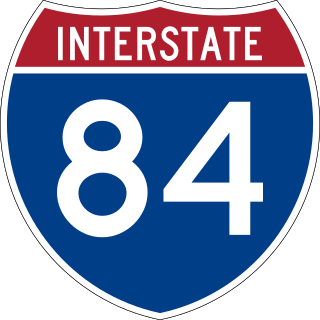
Interstate 84 (I-84) is a part of the Interstate Highway System that runs from Dunmore, Pennsylvania, to Sturbridge, Massachusetts, in the eastern United States. In New York, I-84 extends 71.46 miles (115.00 km) from the Pennsylvania state line at Port Jervis to the Connecticut state line east of Brewster. As it heads east–west across the mid Hudson Valley, it goes over two mountain ranges and crosses the Hudson River at the Newburgh–Beacon Bridge.
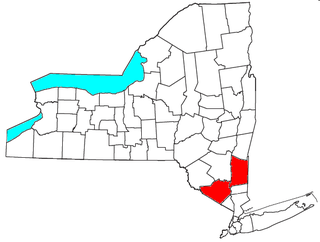
The Kiryas Joel-Poughkeepsie-Newburgh, NY Metropolitan Statistical Area, as defined by the United States Office of Management and Budget, is an area consisting of two counties in New York's Hudson Valley, with the municipalities of Kiryas Joel, Poughkeepsie, and Newburgh as its principal cities. As of the 2020 census, the MSA had a population of 679,221. The area was centered on the urban area of Poughkeepsie-Newburgh.
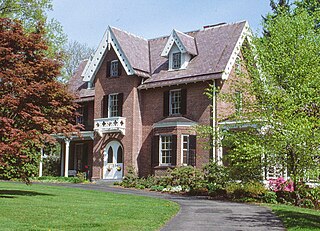
Maple Lawn, also known as the Walter Vail House, is a residence in Balmville, New York, United States built in the Gothic Revival architectural style's Picturesque mode. It was designed by Frederick Clarke Withers, following principles of his late mentor, Andrew Jackson Downing, and commissioned by a wealthy local family in 1859.

Echo Lawn Estate, also known as Stonegate after the Great War, is a historic estate located at Balmville in Orange County, New York. The main house was built about 1860 and is a two-story brick dwelling in the Second Empire style. It features sweeping concave mansard-type roofs. Also on the property is a cluster of mid-19th-century service buildings, an early 20th-century formal garden, and a substantial set of Arts and Crafts inspired gateposts and stone walls.






















